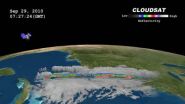Newly discovered planet may have water on its surface
2010-10-01
(Press-News.org) A team of astronomers that includes the University of Hawaiʻi' at Manoa's Nader Haghighipour has announced the discovery of a planet that could have liquid water on its surface.
The planet, which is probably 30 percent larger than Earth, was discovered using one of the telescopes of the W. M. Keck Observatory on Mauna Kea. It orbits a relatively small star, Gliese 581, that is 20 light-years from Earth in the constellation Libra.
"By determining the orbit of this planet, we can deduce that its surface temperature is similar to that of Earth," said Haghighipour. This means that at least some of any water on the surface of the planet and in its atmosphere will be in liquid form rather than ice or vapor. The discovery of liquid water in space is an important step in the search for extraterrestrial life.
The team estimates that the new planet, called Gliese 581g, has a mass three to four times that of Earth, and orbits its star in just under 37 Earth days. Its mass indicates that it is probably a rocky planet with enough gravity to hold on to its atmosphere. It is one of six known planets orbiting the star.
To discover the planet, the team looked for the tiny changes in the star's velocity that arise from the gravitational tugs of its planets. They used 238 separate observations of Gliese 581 taken over a period of 11 years.
Haghighipour said that the team is keeping tabs on many nearby stars using the Keck Observatory. "As we collect more and more data about how these stars are moving, we expect to find many more planets with potentially Earth-like conditions," he said. He noted that to learn more about the conditions on these planets would take even bigger telescopes, such at the Thirty Meter Telescope planned for Mauna Kea.
###
The team that made the discovery is led by Steven Vogt of the University of California, Santa Cruz (UCSC) and Paul Butler of the Carnegie Institution of Washington. Other team members include UCSC associate research scientist Eugenio Rivera, and Gregory Henry and Michael Williamson of Tennessee State University.
This research was supported by grants from the National Science Foundation, NASA, and the NASA Astrobiology Institute.
For a related press release, see http://news.ucsc.edu/2010/09/planet.html.
END
ELSE PRESS RELEASES FROM THIS DATE:
2010-10-01
For the first time, scientists are using advanced technology and an innovative vessel to study, image, and map the unexplored offshore Northern San Andreas Fault from north of San Francisco to its termination at the junction of three tectonic plates off Mendocino, Calif.
The team includes scientists from NOAA's National Marine Fisheries Service, Oregon State University, the California Seafloor Mapping Program, the U.S. Geological Survey and Woods Hole Oceanographic Institution. The expedition which concludes Sunday is sponsored by NOAA's Office of Ocean Exploration and ...
2010-10-01
TORONTO, Sept. 30, 2010 – A waterproof controller designed and built by York University researchers is allowing an underwater robot to go "wireless" in a unique way.
AQUA, an amphibious, otter-like robot, is small and nimble, with flippers rather than propellers, designed for intricate data collection from shipwrecks and reefs.
The robot, a joint project of York, McGill and Dalhousie universities, can now be controlled wirelessly using a waterproof tablet built at York. While underwater, divers can program the tablet to display tags onscreen, similar to barcodes read ...
2010-10-01
NANO -- World's smallest antenna . . .
Instead of the conventional long piece of metal or dipole antenna, electronic devices of tomorrow could incorporate an antenna no bigger than a gnat. This is made possible by a design that allows an electrically charged nano-mechanical oscillator to be tuned to specific electromagnetic waves. "Gone will be the days when we need to match the antenna length to the wavelength," said Panos Datskos, a co-developer of this proprietary technology. The potentially revolutionary system detects very small electric fields over large frequency ...
2010-10-01
High in an alpine meadow, Gesine Pufal, from the University of Wellington, New Zealand, crouched low to the ground and splashed some water from her water bottle on a low green plant cushion, then sat back waiting to see if something would move. Sound crazy? Many hikers passing by her may have thought so, but Pufal was trying to find potential plant species that possess a type of plant movement called hygrochasy.
Although the ability to move is typically thought to be a characteristic unique to the animal kingdom, plants are also capable of movement, from the sudden ...
2010-10-01
Tropical Storm Nicole was a tropical storm for around 6 hours before it weakened into a remnant low pressure area and is now off the Florida coast. NASA Satellite imagery captured different views of Nicole's clouds as the system weakened back into a low pressure area.
While Nicole weakened, a huge trough of low pressure over the U.S. eastern seaboard from Florida to Maine has become the key weathermaker there. The trough, an elongated area of low pressure, is streaming tropical moisture from Nicole's remnants and the Gulf of Mexico, bringing high rainfall totals and severe ...
2010-10-01
A new study, derived from novel sleep research conducted by University of California, San Diego researchers 14 years earlier, suggests that the secret to a long life may come with just enough sleep. Less than five hours a night is probably not enough; eight hours is probably too much.
A team of scientists, headed by Daniel F. Kripke, MD, professor emeritus of psychiatry at UC San Diego School of Medicine, revisited original research conducted between 1995 and 1999. In that earlier study, part of the Women's Health Initiative, Kripke and colleagues had monitored 459 women ...
2010-10-01
When NASA launched the Interstellar Boundary Explorer (IBEX) on October 19, 2008, space physicists held their collective breath for never-before-seen views of a collision zone far beyond the planets, roughly 10 billion miles away. That's where the solar wind, an outward rush of charged particles and magnetic fields continuously spewed by the Sun, runs into the flow of particles and fields that permeates interstellar space in our neighborhood of the Milky Way galaxy.
No spacecraft had ever imaged the collision zone, which occurs in a region known as the heliosheath, because ...
2010-10-01
VIDEO:
See a time-lapse series showing hyper-replication of Salmonella bacteria (red) in epithelial cells from two to seven hours after infection.
Click here for more information.
New findings by National Institutes of Health scientists could explain how Salmonella bacteria, a common cause of food poisoning, efficiently spread in people. In a study published this week in the Proceedings of the National Academy of Sciences, researchers describe finding a reservoir of rapidly ...
2010-10-01
A cheetah lies still in the grass. Finally, a gazelle comes into view. The cheetah plunges forward, reaches sixty-five miles per hour in three seconds, and has the hapless gazelle by the jugular in less than a minute. Then it must catch its breath, resting before eating.
A blue whale surfaces, blasting water high from its blowhole. It breathes in great gasps, filling its thousand-gallon lungs with air. Then it descends again to look for krill, staying below for 10, 20, even 30 minutes before taking another breath.
Both animals need oxygen, of course. And both depend ...
2010-10-01
Ames, Iowa - An Iowa State University researcher searched for new genes that are turned on during infection in a type of mosquito that is not only a pest, but transmits disease-causing pathogens.
Lyric Bartholomay, assistant professor of entomology, along with colleagues from around the world, infected the common southern house mosquito (Culex quinquefasciatus) with various pathogens to see which mosquito genes are activated in response to the infection.
Bartholomay is the first author on the paper, "Pathogenomics of Culex quinquefasciatus and Meta-Analysis of Infection ...
LAST 30 PRESS RELEASES:
[Press-News.org] Newly discovered planet may have water on its surface



